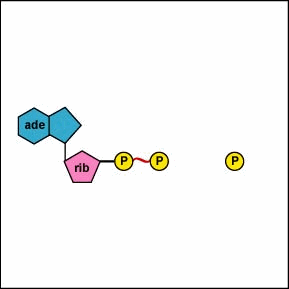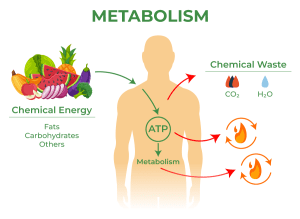
3.4 Cellular Energy: A Fundamental Necessity for Life
Table of Contents
ToggleAll Living Systems Require Energy
All living systems require a constant input of energy to sustain life processes. Energy powers metabolic processes like growth, repair, and reproduction, and helps maintain an organism’s internal environment.
The primary source of energy for most living organisms is the food they consume, which is converted into usable energy through metabolic pathways like cellular respiration. Photosynthetic organisms, such as plants, produce their own energy through photosynthesis, which converts light energy into chemical energy. 🌱
Meet Adenosine Triphosphate!
Most, if not all, energy originates from the sun! This energy is converted into cellular energy by photosynthetic organisms. It can be broken down further into the most basic form of cellular energy, adenosine triphosphate, or simply ATP. 🌞 In general, cellular processes are highly regulated, and energy-producing reactions are often paired with energy-consuming reactions. This balance is crucial for proper cellular function and will be evident when we discuss photosynthesis in more detail.

Order & Entropy
Living organisms are highly ordered systems, but this does not violate the second law of thermodynamics, which states that entropy, or disorder, in a closed system will always increase over time. Living organisms are open systems that exchange matter and energy with their environment, which allows them to maintain a high degree of order.
Energy input must exceed energy loss for organisms to maintain order and support cellular processes—this is known as the principle of energy balance. Cellular processes that release energy, like cellular respiration or fermentation, are often coupled with those that require energy, like synthesizing new molecules or pumping ions across membranes. This efficient energy transfer is key to sustaining life.
When the energy input no longer exceeds energy loss, organisms can no longer sustain their highly ordered state, leading to the inability to maintain essential life processes. This highlights why a constant energy input is critical for survival. 💀

Energy & Metabolism
Energy cannot be created or destroyed, but it can be transformed from one form to another—this is a core concept of energy metabolism. Most energy is ultimately converted into heat due to various metabolic processes, and this will play a role in topics like food webs that are covered later in Unit 8 (Ecology). ⚡
In biological systems, energy is essential to sustain life, and energy-related pathways allow for a controlled and efficient transfer of energy. These pathways are often sequential, where the product of one reaction serves as the reactant for the next.
Key Metabolic Pathways
A prominent example of an energy-related pathway is cellular respiration, which involves converting glucose and oxygen into carbon dioxide, water, and ATP. The process starts with glycolysis—the breakdown of glucose into pyruvate. The pyruvate then enters the citric acid cycle, where it is converted into carbon dioxide and water, and energy is released as ATP. The final stage is the electron transport chain, which generates ATP via oxidative phosphorylation. 🍬
Another important pathway is photosynthesis, where plants convert light energy into chemical energy in the form of glucose. This process occurs in two stages: the light-dependent reactions and the light-independent reactions. In the light-dependent reactions, light energy is converted into ATP and NADPH. These molecules then drive the Calvin cycle to convert carbon dioxide into glucose.
These examples illustrate that energy pathways are tightly regulated to ensure efficient energy transfer and resource conservation within organisms. 🌿

Energy Flow in Nature
Ultimately, all organisms derive energy from plants, regardless of whether they consume plants directly or eat other organisms. Even carnivores rely on the energy originally captured by plants—it is transferred from plants to herbivores and then to carnivores. 🥩
Check out the AP Bio Unit 3 Replays or watch the 2021 Unit 3 Cram
Quiz Question:
What is the primary source of energy for most living organisms?
The food they consume
Oxygen in air
Direct sunlight
Water intake
Correct Answer: The food they consume.
Key Terms to Review
Adenosine Triphosphate (ATP): A high-energy molecule that stores and provides energy for biochemical reactions.
Calvin Cycle: A set of reactions in chloroplasts during photosynthesis that uses light energy to convert carbon dioxide into glucose.
Citric Acid Cycle: Also known as the Krebs cycle, it generates energy through the oxidation of acetyl-CoA into carbon dioxide.
Fermentation: An anaerobic process that produces ATP from glucose without using oxygen.
Photosynthesis: The process by which green plants, algae, and some bacteria convert sunlight into glucose and oxygen.
Recent Posts
- Laws of Indices – Number & Algebra – IB Mathematics AA HL
- Standard Form – Number & Algebra – IB Mathematics AA HL
- 9.2 Crafting an argument through stylistic choices like word choice and description
- 9.1 Strategically conceding, rebutting, or refuting information
- Unit 9 Overview: Developing a Complex Argument
- 8.4 Considering how style affects an argument
- 8.3 Considering how all choices made in an argument affect the audience
- 8.2 Considering how sentence development and word choice affect how the writer is perceived by an audience
- 8.1 Choosing comparisons based on an audience
- Unit 8 Overview: Stylistic Choices
- 7.4 Exploring how sentence development affects an argument
- Syllabus
- Study Guides for every class
- Short Notes
- 7.3 Examining how counterargument or alternative perspectives affect an argument
Choose Topic
- ACT (17)
- AP (20)
- AP Art and Design (5)
- AP Physics 1 (1)
- AQA (5)
- Artificial intelligence (AI) (2)
- Banking and Finance (6)
- Biology (13)
- Business Ideas (68)
- Calculator (72)
- ChatGPT (1)
- Chemistry (3)
- Colleges Rankings (48)
- Computer Science (4)
- Conversion Tools (136)
- Cosmetic Procedures (50)
- Cryptocurrency (49)
- Digital SAT (3)
- Edexcel (4)
- English (1)
- Environmental Science (2)
- Exam Updates (1)
- Finance (17)
- Fitness & Wellness (164)
- Free Learning Resources (209)
- GCSE (1)
- General Guides (40)
- Health (107)
- History and Social Sciences (152)
- IB (1)
- IGCSE (2)
- Image Converters (3)
- IMF (10)
- Math (39)
- Mental Health (58)
- News (8)
- OCR (3)
- Past Papers (463)
- Physics (5)
- SAT (39)
- Schools (3)
- Sciences (1)
- Short Notes (5)
- Study Guides (28)
- Syllabus (19)
- Tools (1)
- Tutoring (1)

